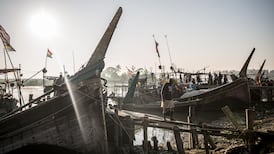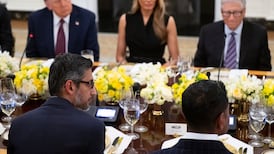George Bush has pushed for an attack on Iran on a basis that US intelligence now says does not exist. The world has had a lucky escape, writes Tony Kinsella
On Wednesday October 17th last, President George Bush told a White House press conference Iran was attempting to develop nuclear weapons, and that if the world was "interested in avoiding world war three" it had to be prevented from doing so.
On Monday, however, the US National Intelligence Council released an eight-page summary of a National Intelligence Estimate (NIE) entitled Iran: Nuclear Intentions and Capabilities (you can read it on the internet via www.dni.gov/press_releases/20071203_release.pdf).
The first key judgment in this estimate states: "We judge with high confidence that in fall 2003, Tehran halted its nuclear weapons programme."
The sketchiest understanding of how National Intelligence Estimates are produced means commander in chief George Bush had either not been briefed on US intelligence debates, or he had and on October 17th was lying.
The US intelligence community is a sprawling maze of agencies and bodies from the Central Intelligence Agency to the Information Analysis and Infrastructure Protection Division of the Department of Homeland Security. In total it includes some 20 different bodies, with a collective budget of more than $40 billion (€27 billion), and employs some 200,000.
The production of an NIE involves all the relevant bodies in the National Intelligence Council. Each agency reviews its intelligence and submits material. The draft is then debated before being released to senior government figures. NIEs thus reflect the agreed collective analysis of the entire intelligence community.
Procedures were tightened in the wake of the Iraqi weapons of mass destruction intelligence fiasco to provide for collegiate debate where different agencies could challenge each other's findings and to insulate analysts from political pressure.
The US intelligence apparatus now agrees with the UN's International Atomic Energy Agency's long-standing assessment that there is "no evidence" of an Iranian nuclear weapon programme, an assessment Russian president Vladimir Putin echoed weeks ago.
A generally accepted view is that Iran's nuclear programmes, including its uranium enrichment centrifuges, are focused on the civil use of nuclear power. The frontier between civil and military use of nuclear power is, however, a thin and permeable one.
Uranium ore cannot be used to generate nuclear power or to equip nuclear weapons. Power generation requires it to be enriched by about 4 per cent, nuclear weapons demand over 90 per cent enrichment.
Iran's Pakistani-designed centrifuges produce 4 per cent enriched uranium, suitable for reactors but not for bombs. This is a distinction that the Bush administration has been careful not to make.
Another missing distinction is that were Iran to push ahead with a weapons programme, which the NIE states could not happen before 2010-2015, it could produce something along the lines of the 1945 US atomic bombs, not today's elaborate thermonuclear warheads.
Washington's scaremongering line has been that Iran is enriching uranium, therefore Iran is producing nuclear weapons. Consequently, we are headed for annihilation in a mushroom cloud of nuclear ash unless Tehran is stopped in its tracks.
The ultimate conclusion of this flawed logic has been articulated by Bush - anything is better than a nuclear armed Iran and if it takes world war three to achieve that, then it is a price worth paying.
Bush's bellicose language has been, as always, amplified by vicepresident Dick Cheney. Many feared that in 2008 the White House duo might choose to leave office in a blaze of righteous explosions.
Veteran investigative journalist Seymour Hersh reported in the New Yorker magazine as far back as August 2006 that the White House had ordered air force planning groups to prepare target lists for strikes on Iranian installations.
In January of this year the White House ordered a second naval carrier group to the Persian Gulf. This triggered the greatest single concentration of US naval strike power anywhere in the world with over 300 F/A-18 fighter attack aircraft especially equipped with JDAM BLU-109 and BLU-119 - so-called Bunker Buster guided bombs.
The US also released similar weapons to Israel to equip its jointly-developed long-range F-15 and F-16 fighter aircraft.
Washington's rhetoric towards bombing Iran eerily echoed the hard-sell of the threat Saddam Hussein's Iraq posed in the lead-up to that ill-starred aggression back in 2002.
The speeches, positioning of equipment and planning exercises were familiar. The careful campaign to establish Iranian supplies as a major cause of US casualties in Iraq smacked of an Oval Office preparing to argue that use of force against Iran was covered by its congressional mandate to attack Iraq.
We stood on the brink of an unjustified and senseless US attack on Iran. This would have been no surgical strike, no glamorous modern day equivalent of a patriotic call to arms. US, and possibly Israeli, aircraft would have bombed Iran's defences to soften up the target. There would most likely have been serial attacks on Iranian air bases, harbours, barracks, and a host of other installations.
Since most experts agreed that such attacks would delay rather than destroy any Iranian nuclear programme, Washington was reported to be considering the use of B61-11 nuclear bunker-busters to radioactively contaminate key sites for years to come.
We can only guess at what the scale of the casualties and the consequences might have been. Thousands of Iranian dead? Overt war in Iraq? In Lebanon? Civil war in Saudi Arabia and the Gulf states? Oil heading for $300 a barrel?
While we can be grateful that the rediscovered professionalism of US public servants has saved us from this particular disaster, the ultimate lesson is more profound.
Decisions as to the collective peace and security of our world must lie in the hands of the UN Security Council. That security council may be flawed. Its five thermonuclear-armed permanent members may be venal and often act more in their own national interests than in that of the whole planet. But it's still preferable to secretive and partisan Washington diatribes as a method of choosing between war and peace.
That is a sobering lesson we would do well to remember.









